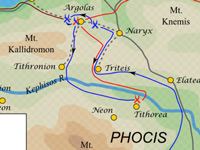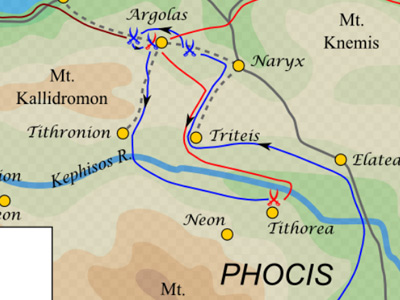Third Sacred War (356–346 BC)

Second Phase (c. 354–353 BC)
The Amphictyons seem to have concluded that their victory at Neon had effectively ended the war, and the Phocians would sue for peace. Otherwise, it is difficult to understand why Pammenes did not march on Delphi, or even sack the undefended Phocian cities in the Kephisos valley. In failing to follow up their victory, the Amphictyons wasted the best opportunity they had during the course of the war to end it. The Thebans seem to have been so sure that the war was ended that they agreed to send 5,000 hoplites under Pammenes to help the rebellion of the Persian satrap Artabazus, shortly after the Battle of Neon. The Thebans needed the money Artabazos offered them, and although they had generally been on good terms with the Persian king, they obviously felt the offer was too good to refuse. It is likely the troops were dispatched before the Phocian decision to fight on became clear, unless the Thebans thought that their remaining troops were a match for any army the Phocians could field. This was to prove a serious mistake for the Thebans, and the Amphictyonic cause in general.
Rather than contemplate surrender after the retreat from Neon, Onomarchos had rallied the Phocians, and insisted that they should continue the war. A meeting of the Phocian Confederation was held to discuss the future course of action, to which their Athenian and Spartan allies were invited. If they surrendered, the Phocians would face additional fines for their sacrilege, and for plundering the treasury; however, to fight on meant perpetrating still further sacrilege, and effectively committed the Phocians to winning a total victory against the Amphictyons. Whilst some were inclined towards peace, the majority were swayed by Onomarchos's orations and policies, quite possibly backed up by the threat of force from the mercenary army, and voted to continue the war. Buckler highlights the particular importance of the Phocian mercenary force on the decisions made by (or for) the Phocian Confederation during the course of the war, and also the peculiar consequences it had for the Phocians: "The primary loyalty of that army would go to its commander and paymaster, not to the Phocian Confederacy. In effect, continued war forced the Phocians to put their faith in the hands of a man who could act regardless of their wishes but the responsibility for whose acts would be theirs."
His position now secure, Onomarchos had his chief opponents arrested and executed, and confiscated their property to add to his war-chest. He then set about raising a new army, doubling the size of Philomelos's force, until he had 20,000 men and 500 cavalry at his disposal. Raising such a large force required extensive depredations of Apollo's wealth; bronze and iron dedications were melted down and recast as weapons, whilst gold and silver offerings were melted down and used to make coinage. Although raising such a large army would have taken a considerable time, Onomarchos had the whole winter after Neon in which to do so.
First conflict in Thessaly (c. 354 BC)
The Sacred War appears to have laid way for renewed conflict within Thessaly. The Thessalian Confederation were in general staunch supporters of the Amphictyonic League, and had an ancient hatred of the Phocians. Conversely, the-city state of Pherae had allied itself with the Phocians. In either 354 or 353 BC the ruling clan of the city of Larissa appealed to Philip II of Macedon to help them defeat Pherae.
Philip thus brought an army into Thessaly, probably with the intention of attacking Pherae. Under the terms of their alliance, Lycophron of Pherae requested aid from the Phocians, and Onormarchos dispatched his brother, Phayllos with 7,000 men; however, Philip repulsed this force before it could join up with the Pheraeans. Onomarchos then abandoned the siege he was currently prosecuting, and brought his whole force into Thessaly to attack Philip. It is possible that Onomarchos hoped to conquer Thessaly in the process, which would both leave the Thebans isolated (Locris and Doris having already fallen to the Phocians), and give the Phocians a majority in the Amphictyonic council, thus enabling them to have the war declared over. Onomarchos probably brought with him 20,000 infantry, 500 cavalry, and a large number of catapults, and outnumbered Philip's army. The exact details of the campaign that followed are unclear, but Onomarchos seems to have inflicted two defeats on Philip, with many Macedonians killed in the process. Polyaenus suggests that the first of Onomarchos's victories was aided by the use of the catapults to throw stones into the Macedonian phalanx, as they climbed a slope to attack the Phocians. After these defeats, Philip retreated to Macedon for the winter. He is said to have commented that he "did not run away but, like a ram, I pulled back to butt again harder".
Second Phocian campaign in Boeotia (c. 353 BC)
In 353 BC, Onomarchos took advantage of the fact that Thebes, financially exhausted, sent out a troop of 5,000 Theban soldiers as mercenaries to support the revolt of Artabazus, satrap of Hellespontine Phrygia, against the Persian king. He led an attack against Locris and captured Thronion, which constituted a key strategic point on the route network of central mainland Greece. He turned south and invaded Doris and eventually Boeotia, where he was finally controlled by the allied Boeotians close to Chaeronea.
Second conflict in Thessaly (c. 353 BC)
Philip returned to Thessaly the next summer (either 353 or 352 BC, depending on the chronology followed), having gathered a new army in Macedon. Philip formally requested that the Thessalians join him in the war against the Phocians; the Thessalians, even if underwhelmed by Philip's performance the previous year, realistically had little choice if they wanted to avoid being conquered by Onomarchos's army. Philip now mustered all the Thessalian opponents of Pherae that he could, and according to Diodorus, his final army numbered 20,000 infantry and 3,000 cavalry.
Pagasae
At some point during his campaigns in Thessaly, Philip captured the strategic port of Pagasae, which was in effect the port of Pherae. It is unclear whether this was during the first or second campaign; both Buckler and Cawkwell suggest that it took place in the second campaign, before the Battle of Crocus Field. By taking Pagasae, it is possible that Philip prevented Pherae from being reinforced by sea during his second campaign. Buckler suggests that Philip had learnt his lesson from the previous campaign, and intended to cut Pherae off from outside help before attacking it.
Battle of Crocus Field
Meanwhile, Onomarchos returned to Thessaly to try to preserve the Phocian ascendancy there, with approximately the same force as during the previous year. Furthermore, the Athenians dispatched Chares to help their Phocian allies, seeing the opportunity to strike a decisive blow against Philip. Subsequent events are unclear, but a battle was fought between the Macedonians and the Phocians, probably as Philip tried to prevent the Phocians uniting forces with the Pheraeans, and crucially, before the Athenians had arrived. According to Diodorus, the two armies met on a large plain near the sea, probably in the vicinity of Pagasae. Philip sent his men into battle wearing crown of laurel, the symbol of the Apollo; "as if he was the avenger...of sacrilege, and he proceeded to battle under the leadership, as it were, of the god". In the ensuing battle, the bloodiest recorded in ancient Greek history, Philip won a decisive victory against the Phocians. In total, 6,000 Phocian troops were killed including Onomarchos, and another 3,000 taken prisoner. Onomarchos was either hanged or crucified and the other prisoners drowned, as ritual demanded for temple-robbers. These punishments were designed to deny the defeated an honourable burial; Philip thus continued to present himself as the pious avenger of the sacrilege committed by the Phocians.
Re-organisation of Thessaly
It was probably in the aftermath of his victory (if not before) that the Thessalians appointed Philip archon of Thessaly. This was an appointment for life, and gave Philip control over all the revenues of the Thessalian Confederation, and furthermore made Philip leader of the united Thesslian army.
Philip was now able to settle Thessaly at his leisure. He first probably finished the siege of Pagasae, to deny the Athenians a landing place in Thessaly. Pagasae was not part of the Thessalian Confederation, and Philip therefore took it as his own, and garrisoned it. The fall of Pagasae now left Pherae totally isolated. Lycophron, rather than suffer the fate of Onomarchos, struck a bargain with Philip, and in return for handing Pherae over to Philip, he was allowed, along with 2000 of his mercenaries, to go to Phocis. Philip now worked to unite the traditionally fractious cities of Thessaly under his rule. He took direct control of several cities in western Thessaly, exiling the dissidents, and in one case refounding the city with a Macedonian population; he tightened his control of Perrhaebia, and invaded Magnesia, also taking it as his own and garrisoning it; "when finished, he was lord of Thessaly."
Thermopylae
Once satisfied with his reorganisation of Thessaly, Philip marched south to the pass of Thermopylae, the gateway to central Greece. He probably intended to follow up his victory over the Phocians by invading Phocis itself, a prospect which greatly alarmed the Athenians, since once he was past Thermopylae, he could also march on Athens. The Athenians therefore dispatched a force to Thermopylae and occupied the pass; there is some debate as to whether other contingents may have joined the Athenians at Thermopylae. The Athenians were certainly there, since the Athenian orator Demosthenes celebrated the defense of the pass in one of his speeches. Cawkwell suggests that the Athenian force was the one that Diodorus says was dispatched under Nausicles consisting of 5,000 infantry and 400 cavalry, and that they were joined by the remnants of the Phocians and the Pheraean mercenaries. However, Buckler argues that Diodorus never mentions Thermopylae, and the force under Nausicles was sent to help the Phocians the following year; instead, he believes that another Athenian force held the pass unassisted. Although it might have proved possible to force the pass, Philip did not attempt to do so, preferring not to risk a defeat after his great successes in Thessaly.
HISTORY

RESOURCES
This article uses material from the Wikipedia article "Third Sacred War (356–346 BC)", which is released under the Creative Commons Attribution-Share-Alike License 3.0.
© Stories Preschool. All Rights Reserved.









